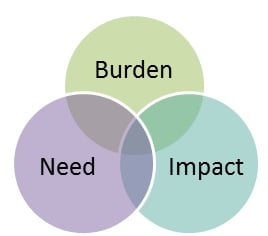Burden, Need, and Impact

How NIOSH Identifies research priorities: Burden, Need, and Impact
NIOSH uses what we refer to as the BNI Method to identify and define research priorities. BNI is the acronym for Burden, Need and Impact. The central tenets of the BNI Method are that NIOSH:
- Must do the most important work to protect the workforce,
- Must identify research priorities to guide the investment of limited resources in a clear and transparent manner, and
- Base these priorities on the evidence of Burden, Need and Impact.
What do we mean by Burden, Need and Impact?
Burden provides evidence of the health and safety and economic burden (or potential burden) of workplace risks and hazards. In considering these burden estimates, we will also consider how well the burden evidence is assessed. Emerging issues, understudied populations or hazards, which would not have established burden due to their emerging nature, would have potential burden that can be described by many of the same parameters of established burden – such as potential for injury, illness, disability and mortality.
Need helps define the knowledge gap the proposed research will fill. It considers the comparative advantage NIOSH has over other funding agencies and the unique resources NIOSH might have to respond to research need. Need is where stakeholder needs are identified and addressed.
Impact is where we consider how well the research is conceived and likely to address the need. Impact or potential for impact helps us consider if the proposed research can create new knowledge, lead others to act on findings, promote practical intervention, adopt a new technology, develop evidence-based guidance, aid in standard setting or promote other intermediate outcomes. Consideration of impact is where we look to see if the proposed research will likely lead to a decrease in worker injury, illness, disability or death, or enhance worker well-being.
Learn More
The BNI method is described in greater detail in the article Burden, Need and Impact: An Evidence-Based Method to Identify Worker Safety and Health Research Priorities. The abstract is below, and the full version of the article is available onlineexternal icon through the journal Annals of Work Exposures and Health.
Abstract:
The importance of research and recommendations to address workforce safety and health derives from the continuing toll from worker fatalities, injuries, and illnesses. Estimates of the societal cost of work-related fatalities, injuries, and illnesses range up to $2.2 trillion in the USA from 2007 to 2015, which may be an underestimate of total societal costs. The ongoing changes in the nature of work, the workforce, and the workplace in the USA challenge old paradigms of worker safety and health research and require new decision criteria that are more solution oriented than observational and that result in interventions that can be readily applied to new occupational hazards and exposures. As public funding for science research programs becomes more constrained, and the demand for increased accountability of government spending grows, the need to demonstrate the impact or return on taxpayers’ investment becomes a necessity for research agencies. The National Institute for Occupational Safety and Health has developed an evidence-based method that uses the criteria of ‘burden’, ‘need’, and ‘impact’ to identify research priorities and aid in the evaluation of the taxpayers’ investment in research. This approach, named the BNI method, may be useful to other public and private sector research agencies or entities that need a systematic way to set research priorities and allocate increasingly scarce resources for research while ensuring the maximal return on investment.
